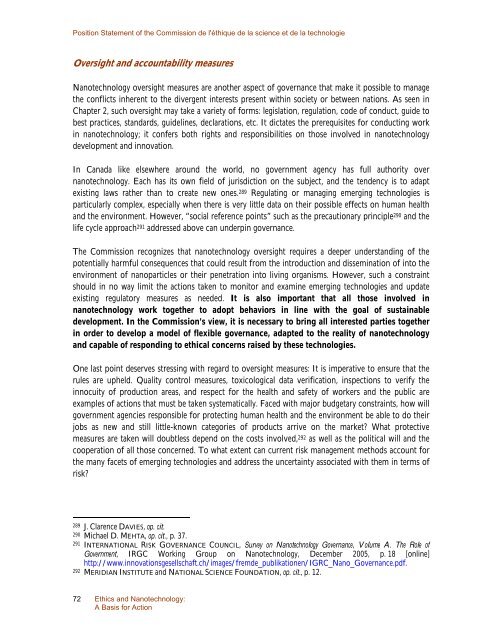A Basis for Action - Commission de l'éthique de la science et de la ...
A Basis for Action - Commission de l'éthique de la science et de la ...
A Basis for Action - Commission de l'éthique de la science et de la ...
Create successful ePaper yourself
Turn your PDF publications into a flip-book with our unique Google optimized e-Paper software.
Position Statement of the <strong>Commission</strong> <strong>de</strong> l'éthique <strong>de</strong> <strong>la</strong> <strong>science</strong> <strong>et</strong> <strong>de</strong> <strong>la</strong> technologie<br />
Oversight and accountability measures<br />
Nanotechnology oversight measures are another aspect of governance that make it possible to manage<br />
the conflicts inherent to the divergent interests present within soci<strong>et</strong>y or b<strong>et</strong>ween nations. As seen in<br />
Chapter 2, such oversight may take a vari<strong>et</strong>y of <strong>for</strong>ms: legis<strong>la</strong>tion, regu<strong>la</strong>tion, co<strong>de</strong> of conduct, gui<strong>de</strong> to<br />
best practices, standards, gui<strong>de</strong>lines, <strong>de</strong>c<strong>la</strong>rations, <strong>et</strong>c. It dictates the prerequisites <strong>for</strong> conducting work<br />
in nanotechnology; it confers both rights and responsibilities on those involved in nanotechnology<br />
<strong>de</strong>velopment and innovation.<br />
In Canada like elsewhere around the world, no government agency has full authority over<br />
nanotechnology. Each has its own field of jurisdiction on the subject, and the ten<strong>de</strong>ncy is to adapt<br />
existing <strong>la</strong>ws rather than to create new ones. 289 Regu<strong>la</strong>ting or managing emerging technologies is<br />
particu<strong>la</strong>rly complex, especially when there is very little data on their possible effects on human health<br />
and the environment. However, “social reference points” such as the precautionary principle 290 and the<br />
life cycle approach 291 addressed above can un<strong>de</strong>rpin governance.<br />
The <strong>Commission</strong> recognizes that nanotechnology oversight requires a <strong>de</strong>eper un<strong>de</strong>rstanding of the<br />
potentially harmful consequences that could result from the introduction and dissemination of into the<br />
environment of nanoparticles or their pen<strong>et</strong>ration into living organisms. However, such a constraint<br />
should in no way limit the actions taken to monitor and examine emerging technologies and update<br />
existing regu<strong>la</strong>tory measures as nee<strong>de</strong>d. It is also important that all those involved in<br />
nanotechnology work tog<strong>et</strong>her to adopt behaviors in line with the goal of sustainable<br />
<strong>de</strong>velopment. In the <strong>Commission</strong>’s view, it is necessary to bring all interested parties tog<strong>et</strong>her<br />
in or<strong>de</strong>r to <strong>de</strong>velop a mo<strong>de</strong>l of flexible governance, adapted to the reality of nanotechnology<br />
and capable of responding to <strong>et</strong>hical concerns raised by these technologies.<br />
One <strong>la</strong>st point <strong>de</strong>serves stressing with regard to oversight measures: It is imperative to ensure that the<br />
rules are upheld. Quality control measures, toxicological data verification, inspections to verify the<br />
innocuity of production areas, and respect <strong>for</strong> the health and saf<strong>et</strong>y of workers and the public are<br />
examples of actions that must be taken systematically. Faced with major budg<strong>et</strong>ary constraints, how will<br />
government agencies responsible <strong>for</strong> protecting human health and the environment be able to do their<br />
jobs as new and still little-known categories of products arrive on the mark<strong>et</strong>? What protective<br />
measures are taken will doubtless <strong>de</strong>pend on the costs involved, 292 as well as the political will and the<br />
cooperation of all those concerned. To what extent can current risk management m<strong>et</strong>hods account <strong>for</strong><br />
the many fac<strong>et</strong>s of emerging technologies and address the uncertainty associated with them in terms of<br />
risk?<br />
289 J. C<strong>la</strong>rence DAVIES, op. cit.<br />
290 Michael D. MEHTA, op. cit., p. 37.<br />
291 INTERNATIONAL RISK GOVERNANCE COUNCIL, Survey on Nanotechnology Governance, Volume A. The Role of<br />
Government, IRGC Working Group on Nanotechnology, December 2005, p. 18 [online]<br />
http://www.innovationsgesellschaft.ch/images/frem<strong>de</strong>_publikationen/IGRC_Nano_Governance.pdf.<br />
292 MERIDIAN INSTITUTE and NATIONAL SCIENCE FOUNDATION, op. cit., p. 12.<br />
72 Ethics and Nanotechnology:<br />
A <strong>Basis</strong> <strong>for</strong> <strong>Action</strong>
















